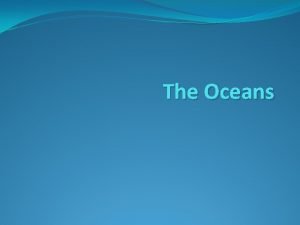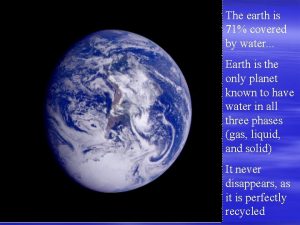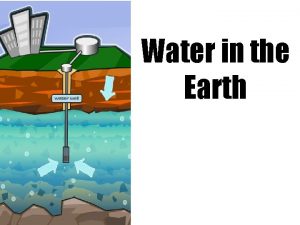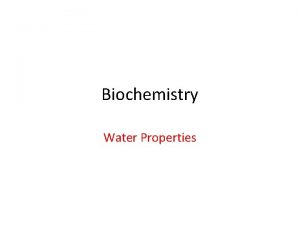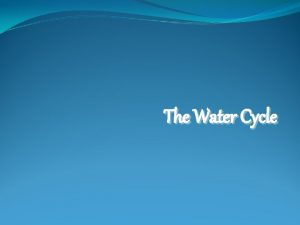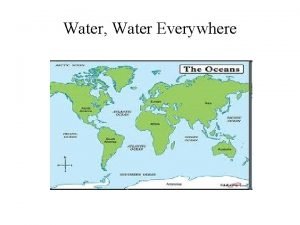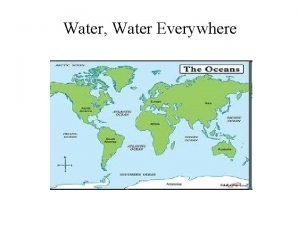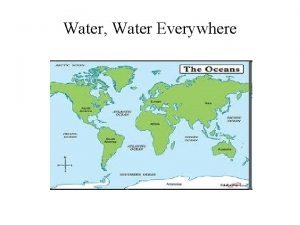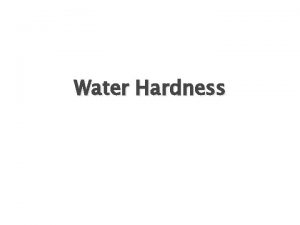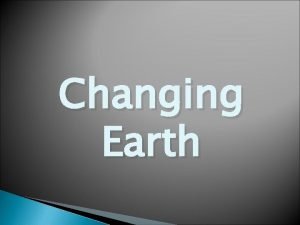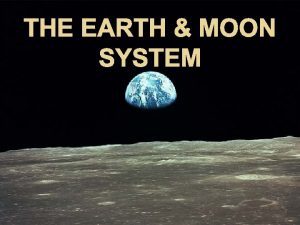Water 71 of the Earth is Covered in




































- Slides: 36

Water

71% of the Earth is Covered in Water Although water covers over 70 percent of the Earth, less than 1 percent (0. 3%) is available as freshwater for human use. The vast majority of the water on this “blue planet” is found in the ocean, and is salt-water. It is unusable to us. Of the freshwater available on Earth, about two-thirds is frozen in ice caps and glaciers, which leaves only a small fraction accessible for human use.

Freshwater Surface water - such as that in lakes, reservoirs, rivers, and streams—is the primary water source for humans. (0. 3%) Groundwater - water underground in aquifers (highly permeable rocks, soil, and sand)— can be extracted through wells or found as springs. This is NOT our primary source!

Why not use Salt Water? TOO EXPENSIVE!!! Can cost over $1, 000 per acrefoot to desalinate (unsalt) seawater to make it available for human use.

Did you know? • There is the SAME water on Earth as there was when the Earth was formed. The water from your faucet could contain molecules that dinosaurs drank. HOW is that possible?

The Water Cycle Water is constantly being renewed in the water cycle!

A short Water Cycle Video http: //www. youtube. com/watch? v=St. Pob. H 5 ODTw&feature=related

The Water Cycle Rap https: //www. youtube. com/watch? v=i 3 Ne. M VBc. XXU

Water Cycle Vocabulary Terms

Evaporation The turning of liquid water into a gas

Transpiration • Water evaporating from plant leaves

Condensation • Water turning from a gas into a liquid

Precipitation • Water falling back to Earth in the form of rain, snow, sleet or hail

Runoff • Water flowing over the Earth’s surface

Infiltration • Infiltration is the process by which water enters the soil from the ground surface. • Will only happen if there is room available for additional water in the soil. • If no room is available, then runoff occurs.

Percolation • The movement of water through the soil

Humans affect the cycle… • Create dams and reservoirs for use, irrigation, electricity

Ground Water Where is it located? How does it get there?

Where is ground water located? When precipitation hits the soil where does the water go? The water moves into the spaces between the particles of sand. Groundwater is stored in-and moves slowly through --layers of soil, sand rocks called aquifers.

How does the water get into the soil? Infiltration and Percolation

Porosity & Permeability • Porosity – percent of rock that contains pore spaces. • Permeability – the measure of ability to transmit fluids

Porosity and Permeability

Aquifers The area where water fills the aquifer is called the saturated zone. The top of this zone is called the water table.

The Water Table The water table may be located only a foot below the ground’s surface or it can sit hundreds of feet down.

How can ground water be used? Water in aquifers is brought to the surface naturally through a spring or can be discharged into lakes and streams. Groundwater can also be extracted through a well drilled into the aquifer. Groundwater supplies are replenished, or recharged, by rain and snow melt.

Water Use How much water does it take to produce… 1 slice of bread? More than 10 gallons 1 cotton T-shirt? More than 713 gallons 1 gallon of milk? 1000 gallons 1 hamburger? 634 gallons

Water Shortages In some areas of the world, people face serious water shortages because groundwater is used faster than it is naturally replenished. In other areas groundwater is polluted by human activities.

No Access to safe drinking water Did you know…American residents use about 100 gallons of water per day person. Residents of sub-Saharan Africa use only 2 -5 gallons of water per day

Clean Water

Water Diseases

The future of water? !? Why should you care?

Generally. . . You can survive • • • 3 minutes without oxygen 3 days without water 3 weeks without food Unless you are Superman!

You are 70 % water

Bottled Water – Friend or Foe? If you drink your daily recommended 8 glasses of water per day from the tap, it will cost you about 50 cents per year. If you choose to drink it from water bottles, it will cost you about $1, 400 dollars. More than 25% of bottled wate comes from a municipal water supply, the same place that tap water comes from.


Quiz Vocabulary • Water Cycle • Condensation • Precipitation • Transpiration • Evaporation • Runoff • Uptake • Infiltration • Aquifer • Water Table • Ground Water • Percolation • Porosity • Permeability
 How much of the earth's surface is covered with water
How much of the earth's surface is covered with water Earth covered in water
Earth covered in water 71 of earth is covered with water
71 of earth is covered with water Water and water and water water
Water and water and water water Hát kết hợp bộ gõ cơ thể
Hát kết hợp bộ gõ cơ thể Frameset trong html5
Frameset trong html5 Bổ thể
Bổ thể Tỉ lệ cơ thể trẻ em
Tỉ lệ cơ thể trẻ em Chó sói
Chó sói Thang điểm glasgow
Thang điểm glasgow Hát lên người ơi alleluia
Hát lên người ơi alleluia Môn thể thao bắt đầu bằng chữ đua
Môn thể thao bắt đầu bằng chữ đua Thế nào là hệ số cao nhất
Thế nào là hệ số cao nhất Các châu lục và đại dương trên thế giới
Các châu lục và đại dương trên thế giới Công thức tính thế năng
Công thức tính thế năng Trời xanh đây là của chúng ta thể thơ
Trời xanh đây là của chúng ta thể thơ Mật thư tọa độ 5x5
Mật thư tọa độ 5x5 101012 bằng
101012 bằng độ dài liên kết
độ dài liên kết Các châu lục và đại dương trên thế giới
Các châu lục và đại dương trên thế giới Thơ thất ngôn tứ tuyệt đường luật
Thơ thất ngôn tứ tuyệt đường luật Quá trình desamine hóa có thể tạo ra
Quá trình desamine hóa có thể tạo ra Một số thể thơ truyền thống
Một số thể thơ truyền thống Cái miệng nó xinh thế
Cái miệng nó xinh thế Vẽ hình chiếu vuông góc của vật thể sau
Vẽ hình chiếu vuông góc của vật thể sau Thế nào là sự mỏi cơ
Thế nào là sự mỏi cơ đặc điểm cơ thể của người tối cổ
đặc điểm cơ thể của người tối cổ V cc cc
V cc cc Vẽ hình chiếu đứng bằng cạnh của vật thể
Vẽ hình chiếu đứng bằng cạnh của vật thể Vẽ hình chiếu vuông góc của vật thể sau
Vẽ hình chiếu vuông góc của vật thể sau Thẻ vin
Thẻ vin đại từ thay thế
đại từ thay thế điện thế nghỉ
điện thế nghỉ Tư thế ngồi viết
Tư thế ngồi viết Diễn thế sinh thái là
Diễn thế sinh thái là Dạng đột biến một nhiễm là
Dạng đột biến một nhiễm là Số nguyên tố là gì
Số nguyên tố là gì

